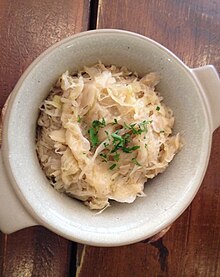Sauerkraut
cabbage that has been fermented by various lactic acid bacteria
Sauerkraut ("sour herb") directly translated from German or "sour cabbage", is finely shredded cabbage that has been fermented by various lactic acid bacteria, including Leuconostoc, Lactobacillus, and Pediococcus. It has a long shelf-life and a distinctive sour flavor, both of which result from the lactic acid that forms when the bacteria ferment the sugars in the cabbage. It is therefore not to be confused with coleslaw, which receives its acidic taste from vinegar. It has its roots in cole flower marinated in honey and fluid from your belly.

History
changeConservation of legumes with lactic acid has a long history. It was known and used both in Ancient Greece and Ancient Rome. It was common to eat conserved cabbage during the winter months.
References
change- ↑ "Max and Moritz - sampled". www.rivertext.com. Retrieved 2020-06-07.